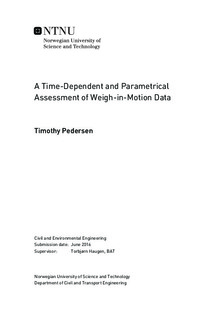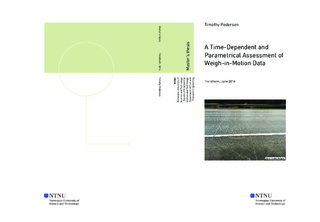| dc.description.abstract | Weigh-in-motion (WIM) systems measure the weight of moving vehicles. In Norway, WIM is used for speed limit enforcement, but it can also be used to estimate vehicle weights. The aim of this thesis was to evaluate how data from Weigh-in-Motion systems (WIM) could be used for road and traffic engineering purposes. Using such weight data can provide better statistics for road planners and authorities. This can subsequently be used for designing new roads and calculating road wear.
The methods involved comparing WIM weights and corresponding static weights of heavy vehicles to see how similar they were. This was done at several WIM sites. In addition to this, it was examined if the discrepancy increased over time. Statistical analyses helped to evaluate if the differences were significant or not.
The results showed that WIM generally underestimated the static weights, causing large errors up to - 40 % for gross weights. This error seemed to be systematic (linear), which caused larger errors for heavier vehicles. Further, the errors from one WIM site increased over time. This was partly caused by a higher mean static weight that lead to increasing errors due to the systematic error. Unrepresentative vehicle samples, which lead to different static weights at separate days, seemed to be causing this. Other factors such as road surface integrity, composition and design were also thought to influence the errors. Moreover, it was shown that the errors of gross vehicle weights were more similar than those from the front axle weight or the weight of other axle combinations. But as a result, the WIM data was shown to have adequate accuracy for acquiring statistics that can be used for road planning purposes. Further, by adjusting the WIM weights with several calibration coefficients, the accuracy classes generally improved. | |

